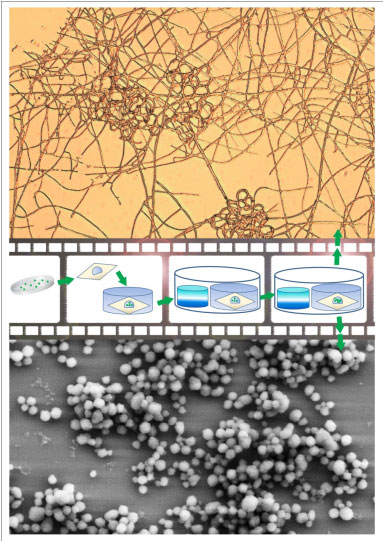| Posted: Dec 18, 2012 | |
Flesh-eating fungus produces cancer-fighting nanoparticles |
|
| (Nanowerk Spotlight) Naturally occurring nanomaterials can be found everywhere in nature – in soil, ground and surface waters, volcanic ash, ocean spray, mineral composites, smoke – (fullerenes and graphene even have been discovered in space) and only with recent advances in instrumentation and metrology equipment are researchers beginning to locate, isolate, characterize and classify the vast range of their structural and chemical varieties (read more: "Natural nanomaterials - they are everywhere"). | |
| Biogenic magnetite nanoparticles have even been discovered in various organisms, ranging from bacteria to human brains, with various biological functions. | |
| "Most studies on naturally occurring organic nanoparticles have focused on higher organisms," Mingjun Zhang, an associate professor of biomedical engineering at the University of Tennessee, Knoxville, tells Nanowerk. "Given the earth’s rich biological diversity, it is reasonable to hypothesize that naturally occurring nanoparticles, of various forms and functions, may be produced by a wide range of organisms from microbes to metazoans." | |
| In his research, Zhang has focused on looking at nature for inspirations for solutions to challenges in engineering and medicine, especially in small-scale, such as bioinspired nanomaterials, bioinspired energy-efficient propulsive systems, and bioinspired nanobio systems for interfacing with cellular systems. In previous Nanowerk Spotlights, we have reported about his work to replace metal-based nanoparticles in sunscreen with natural nanoparticles and to explore the use of nanoparticles secreted from ivy for adhesive applications. | |
| In new work, Zhang and his research associate Dr. Yongzhong Wang have turned their focus to Arthrobotrys oligospora, a representative flesh eater with a predatory life stage in the fungal kingdom. | |
 |
|
| A nematode-trapping fungus, Arthrobotrys oligospora, cultured in a sitting drop culture system, produces abundent spherical nanoparticles. They contain glycosaminoglycan and protein components, and demonstrate the potential activity as an immunostimulatory and antitumor agent for cancer immunochemotherapy. (Image: Dr. Zhang, The University of Tennessee) | |
| Reporting their findings in the December 4, 2012, online edition of Advanced Functional Materials ("Naturally Occurring Nanoparticles from Arthrobotrys oligospora as a Potential Immunostimulatory and Antitumor Agent"), the team have discovered that nanoparticles produced by A. oligospora hold promise for stimulating the immune system and killing tumors. | |
| "It is really exciting to use a natural microbe system to produce nanoparticles for potential cancer therapy," says Zhang. "Originally, we were trying to understand how the fungus secretes an adhesive trap that can capture, penetrate, and digest free-living nematodes in diverse environments. By doing that we almost accidentally discovered the nanoparticles produced." | |
| Nanoparticles already have found widespread applications in novel nanomedicine cancer therapies (see for instance: "Ultrasmall nanoparticles show promise as anti-cancer agents"). Due to their high surface-to-volume ratio, nanoparticles demonstrate unique optical, thermal and electrical properties. In addition, their small size allows them to easily cross cell membranes, an essential requirement for delivering drugs to tumor cells. | |
| Zhang's team investigated the fungal nanoparticles' potential as a stimulant for the immune system, and found through an in vitro study that the nanoparticles activate secretion of an immune-system stimulant within a white blood cell line. They also investigated the nanoparticles' potential as an antitumor agent by testing in vitro the toxicity to cells using two tumor cell lines, and discovered nanoparticles do kill cancer cells. | |
| The researchers used a new culture method – fungal sitting drop culture method – that allowed them to observe fungal growth, as well as both secreted and surface-bound nanomaterials using light microscopy, scanning electron microscopy (SEM), and atomic force microscopy (AFM) without any disturbance from agar components present in solid media. Using this culture method, they were able to observe secreted nanoparticles, and characterize them. | |
| Zhang notes that this discovery is the first step towards the development of natural nanoparticle-based therapeutics for cancer treatment and demonstrates the importance of looking to nature for innovation in disease treatment. | |
 By
Michael
Berger
– Michael is author of three books by the Royal Society of Chemistry:
Nano-Society: Pushing the Boundaries of Technology,
Nanotechnology: The Future is Tiny, and
Nanoengineering: The Skills and Tools Making Technology Invisible
Copyright ©
Nanowerk LLC
By
Michael
Berger
– Michael is author of three books by the Royal Society of Chemistry:
Nano-Society: Pushing the Boundaries of Technology,
Nanotechnology: The Future is Tiny, and
Nanoengineering: The Skills and Tools Making Technology Invisible
Copyright ©
Nanowerk LLC
|
|
|
Become a Spotlight guest author! Join our large and growing group of guest contributors. Have you just published a scientific paper or have other exciting developments to share with the nanotechnology community? Here is how to publish on nanowerk.com. |
|
